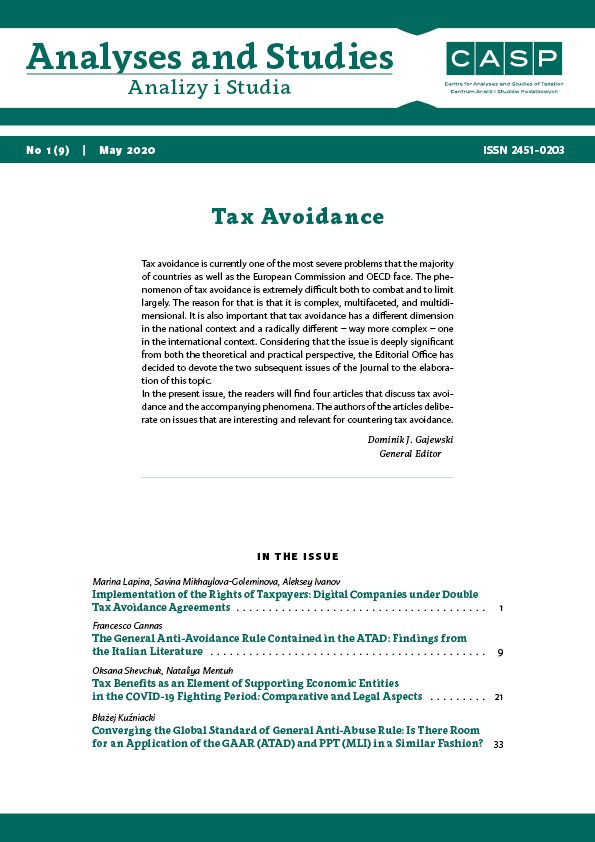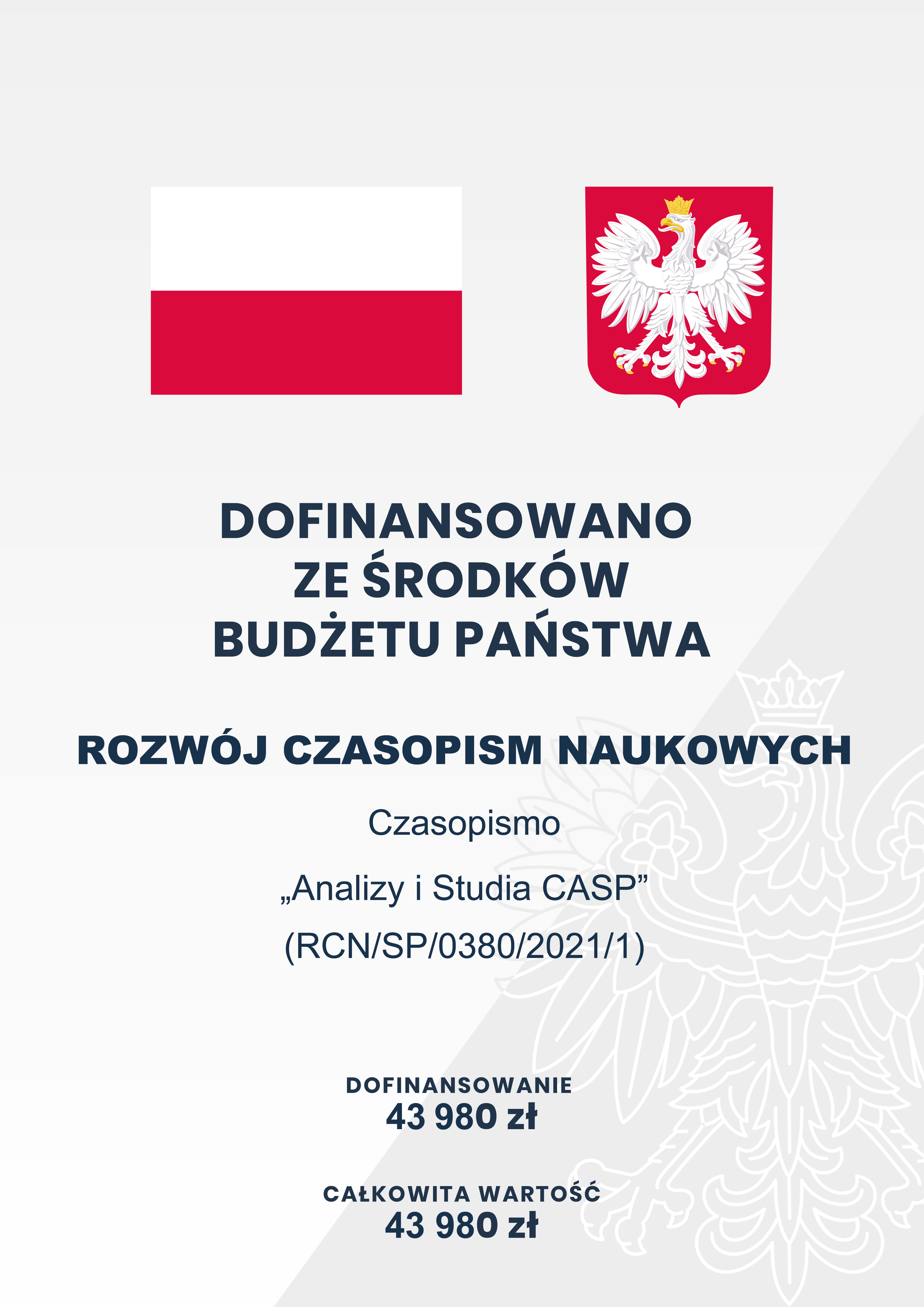Zbiegający się globalny standard przeciwdziałania nadużyciom prawa podatkowego: Czy GAAR (ATAD) i PPT (MLI) powinny być stosowane w podobny sposób?
DOI:
https://doi.org/10.33119/ASCASP.2020.1.4Słowa kluczowe:
globalna polityka podatkowa, unikanie opodatkowania, GAAR, PPT, OECD, BEPS, MLI, UE, ATADAbstrakt
Potrzeba znalezienia środków z podatków na finansowanie funkcjonowania państw oraz coraz większa nieufność polityków i opinii publicznej wobec schematów optymalizacji podatkowej przedsiębiorstw wielonarodowych (multinational enterprises, MNE) i najbardziej majętnych osób fizycznych (high-net worth individuals, HNWI) wywołały bezprecedensowy entuzjazm polityczny dotyczący przeciwdziałania międzynarodowemu unikaniu opodatkowania. Ten entuzjazm przerodził się w mandat polityczny udzielony OECD przez G20 w 2012 r. Wśród mnogości propozycji środków prawnych przeciwdziałających unikaniu opodatkowania opracowanych przez OECD w ramach projektu BEPS, za kluczowe należy uznać: test jednego z głównych celów (principal purposes test, PPT) z MLI i ogólną klauzulę przeciwdziałania unikaniu opodatkowania (general anti-avoidance rule, GAAR) z unijnej dyrektywy przeciwdziałającej praktykom unikania opodatkowania (anti-tax avoidance directive, ATAD). Celem niniejszego artykułu jest znalezienie odpowiedzi na główne (tytułowe) pytanie badawcze: Czy GAAR (ATAD) i PPT (MLI) powinny być stosowane w podobny sposób? Hipotezą pozytywnie zweryfikowaną w ramach niniejszego opracowania jest to, że: im bardziej zbiegające się (koherentne) będzie stosowanie GAAR i PPT, tym mniej praktyk unikania opodatkowania i sporów wynikających z tego zjawiska będzie występować między podatnikami i organami podatkowymi. Istnieje jednak poważne zastrzeżenie: GAAR i PPT powinny być stosowane zgodnie z ogólną zasadą przeciwdziałania nadużyciom (general anti-abuse principle, GAAP) wynikającą z orzecznictwa Trybunału Sprawiedliwości Unii Europejskiej (TSUE), a nie zgodnie z PPT zaprojektowanym przez OECD. Tylko takie podejście do stosowania GAAR i PPT może zapewnić właściwą równowagę między interesami fiskalnymi różnych państw a swobodami gospodarczymi podatników. Konstatacja ta wynika z analizy treści i struktury GAAR i PPT, celów polityki podatkowej wyrażonych w preambułach do MLI i ATAD, orzecznictwa Trybunału Sprawiedliwości Unii Europejskiej (TSUE), Komentarza OECD do Modelu Konwencji OECD oraz literatury.
Bibliografia
Argentina-Brazil (1980 and 2017), The protocol amending the Convention between the Argentine Republic and the Federative Republic of Brazil for the Avoidance of Double Taxation and the Prevention of Fiscal Evasion with respect to Taxes on Income, Treaties IBFD, 21 July 2017.
Arnold, B. (2002). Reflections on the Relationship Between Statutory Interpretation and Tax Avoidance. [In:] H. Erlichman (Ed.), Tax avoidance in Canada: the general anti-avoidance rule. Toronto: Irwin Law.
ATAD (2016). Council Directive (EU) 2016/1164 of 12 July 2016 Laying Down Rules against Tax Avoidance Practices that Directly Affect the Functioning of the Internal Market, OJ L 193/1.
Atiyah, P.S. and Summers, R.S. (1987). Form and substance in Anglo-American law: a comparative study of legal reasoning, legal theory, and legal institutions. Oxford: Clarendon.
Avi-Yonah, R.S. and Mazzoni, G. (2018). The text below from BEPS, ATAP, and the New Tax Dialogue: A Transatlantic Competition? Intertax, Vol. 46, No. 11.
Avi-Yonah, R.S. (2007). Tax competition, tax arbitrage, and the future of the international tax regime. [In:] International Tax as International Law an Analysis of the International Tax Regime. Cambridge: Cambridge University Press 2007.
Baker, P. (2017). The BEPS Action Plan in the Light of EU Law: Treaty Abuse. British Tax Review, No. 3.
Commission (2016). Proposal for a Council Directive laying down rules against tax avoidance practices that directly affect the functioning of the internal market. Brussels, 28.1.2016 COM(2016) 26 final 2016/0011 (CNS).
Council Directive (EU) 2017/1852, Council Directive (EU) 2017/1852 of 10 October 2017 on tax dispute resolution mechanisms in the European Union, OJ L 265, 14.10.2017, p. 1–14.
Dabner, J. (2000). The Spin of a Coin – In Search of a Workable GAAR. Journal of Australian Taxation, No. 3.
De Broe, L. (2008). International Tax Planning and Preventionof Abuse: A Study under Domestic Tax Law, Tax Treaties and EC Law in Relation to Conduit and Base Companies. Doctoral Series IBFD – Academic Council, Vol. 14, Amsterdam: IBFD.
De la Feira, R. (2020). EU General Anti-Avoidance Mechanisms: From GAAP to GAAR. [In:] G. Loutzenhiser and R. De la Feria (Eds.). The Dynamics of Taxation. Oxford: Hart Publishing, (forthcoming in 2020).
Retrieved from: https://papers.ssrn.com/sol3/papers.cfm?abstract_id=3485784 (accessed: 11.4.2020).
Douma, S.C.W. (2018). Miscommunication and Distrust in the International Tax Debate. Deventer: Wolters Kluwer.
Freedman, J. (2019). The UK General Anti-Avoidance Rule: Transplants and Lessons. Bulletin for International Taxation, Vol. 73, No. 6/7.
Fung, S. (2017). The Questionable Legitimacy of the OECD/G20 BEPS Project. 10 Erasmus Law Review, Vol. 10, No. 2.
G20 (2012). Los Cabos Communique, 18–19 June 2012.
Gomułowicz, A. (2019). Klauzula przeciwko unikaniu opodatkowania, czyli – Ave Caesar morituri te salutant. Przegląd Podatkowy, No. 10.
Gordon, K. and Pohl, J. (2015). Investment Treaties over Time - Treaty Practice and Interpretation in a Changing World. OECD Working Papers on International Investment 2015/02.
Hattingh, P.J. (2018). The Impact of the BEPS Multilateral Instrument on International Tax Policies. Bulletin for International Taxation, Vol. 72, No. 4/5.
ICIJ (2020). Offshore Leaks Database. The International Consortium of Investigative Journalists. Retrieved from: https://offshoreleaks.icij.org (accessed:11.4.2020).
Kuźniacki, B. (2018). The Limitation on the Benefits (LOB) Rule in BEPS Action 6/MLI: Ineffective Overreaction of Mind–Numbing Complexity – Part 2. Intertax, Vol. 46, Iss. 2.
Kuźniacki, B. (2018). The Principal Purpose Test (PPT) in BEPS Action 6 and the MLI: Exploring Challenges Arising from Its Legal Implementation and Practical Application. World Tax Journal, Vol. 10, No. 2.
Kuźniacki, B. (2019). The C.J.E.U. Case Law Relevant to the General Anti-Avoidance Rule (G.A.A.R.) Under the Anti-Tax Avoidance Directive (A.T.A.D.). University of Bologna Law Review, Vol. 4, Iss. 2. Retrieved from: https://doi.org/10.6092/issn.2531-6133/10023 (accessed:11.4.2020).
Kuźniacki, B. (2019a). The ECJ as a Protector of Tax Optimization via Holding Companies. Intertax, Vol. 47, Iss. 3.
Kuźniacki, B. (2020). Chapter 7: The GAAR (Article 6 ATAD). [In:] W. Haslehner, G.W. Koefler, A. Rust (Eds.), A Guide to the Anti-Tax Avoidance Directive. Edward Elgar Tax Practice Series (forthcoming 2020).
Kuźniacki, B. (2020a). Dekodowanie hipotezy GAAR: (1) Przesłanki intencji i sprzeczności oraz relacje między nimi (1) oraz (2) Przesłanka sztuczności i jej wpływ na przesłankę sprzeczności. Przegląd Podatkowy, No. 6 and 7.
Ladziński, A. (2019). Zmiany w ogólnej klauzuli przeciwko unikaniu opodatkowania – powrót do przeszłości. Przegląd Podatkowy, No. 1.
Lang, et al. (2016). GAARs - A Key Element of Tax Systems in the Post-BEPS World. Amsterdam: IBFD.
Lang, M. (2014). BEPS Action 6: Introducing an Antiabuse Rule in Tax Treaties. Tax Notes International, May 19.
Martı́n Jiménez, A. (2016). Tax Avoidance and Aggressive Tax Planning as an International Standard – BEPS and the “New” Standards of (Legal and Illegal) Tax Avoidance’. [In:] A. Dourado (Ed.). Tax Avoidance Revisited in the EU BEPS Context: EATPL Annual Congress Munich 2–4 June 2016. 15 EATLP International Tax Series, 2017, sec. 2.5.2.
Mclaren, J. (2008), The Distinction Between Tax Avoidance and Tax Evasion Has Become Blurred in Australia: Why Has It Happened? Journal of the Australasian Tax Teachers Association, Vol. 3, No. 2.
Mengozzi, P. (Advocate General). Opinion of Advocate General Mengozzi, 5 June 2018, Case C-135/17, X-GmbH v. Finanzamt Stuttgart – Körperschaften.
MLI (2017). Multilateral Convention to Implement Tax Treaty Related Measures to Prevent BEPS, Paris 2017. Retrieved from: https://www.oecd.org/ctp/treaties/multilateral-convention-to-implement-tax-treaty-related-measures-to-prevent-beps.htm (accessed:11.4.2020).
Moreno, A.B. and Zornoza Pérez, J.J. (2019), The General Anti-abuse Rule of the Anti-tax Avoidance Directive. [In:] J.M. Almudí Cid, J.A. Ferreras Gutiérrez and P.A. Hernández González-Barreda (Eds.). Combating Tax Avoidance in the EU: Harmonization and Cooperation in Direct Taxation. Alphen aan den Rijn: Kluwer Law International.
Moreno, A.B. (2017), GAARs and Treaties: From the Guiding Principle to the Principal Purpose Test. What Have We Gained from BEPS Action 6? 45 Intertax, No. 6/7.
Neck R., Wächter J.U. and Schneider F. (2012), Tax avoidance versus tax evasion: on some determinants of the shadow economy, International Tax Public Finance 2012, Vol. 19, No. 1.
OECD (2013). Addressing Base Erosion and Profit Shifting, International Organizations. Paris: OECD.
OECD (2015a). BEPS 2015 Final Reports. Retrieved from: https://www.oecd.org/ctp/beps-2015-final-reports.htm (accessed: 11.4.2020).
OECD (2015b). Preventing the Granting of Treaty Benefits in Inappropriate Circumstances – Action 6: 2015 Final Report. Paris: OECD.
OECD (2017). The OECD’s Commentary the Model Tax Convention 2017. Paris: OECD.
OECD (2020). Signatories and Parties to the Multilateral Convention to Implement Tax Treaty related Measures to Prevent Base Erosion and Profit Shifting, Status as of 11 March 2020. Retrieved from: http://www.oecd.org/tax/treaties/beps-mli-signatories-and-parties.pdf (accessed: 11.4.2020).
OJ L 265, 14.10.2017, p. 1–14.
Palao Taboada, C. (2015). OECD Base Erosion and Profit Shifting Action 6: The General Anti-Abuse Rule. Bulletin for International Taxation, Vol. 69, No. 10.
Prats, G. et al. (2018), EU Report: Anti-avoidance measures of general nature and scope – gaar and other rules. IFA Cashiers, Vol. 103A.
Samples, T.R. (2019). Winning and Losing in Investor–State Dispute Settlement. American Business Law Journal, Vol. 56, No. 1.
Schön, W. (2010). Legalität, Gestaltungsfreiheit und Belastungsgleichheit als Grundlage des Steuerrechts. [In:] T. Hüttermann (Ed.). Gestaltungsfreiheit und Gestaltungsmissbrauch im Steuerrecht. Köln: Dr. Otto Schmidt.
Schön, W. (2020). Interpreting European Law in the Light of the OECD/G20 Base Erosion and Profit Shifting Action Plan. Bulletin for International Taxation, Vol. 74, No. 4/5.
Schwarz, J. (2018). Multilateral or bilateral Implementation of BEPS Treaty-related measures? Swiss-UK and UK-Uzbekistan Protocol show the way. Kluwer International Tax Blog, 21 February 2018. Retrieved from: http://kluwertaxblog.com/2018/02/21/multilateralbilateral-implementation-beps-treaty-related-measures (accessed: 11.4.2020).
Shiers, R. and Miller, P. (2007). The Whole or Main Purpose Test. Tax Journal, Iss. 876, 12 March.
Singapore-Brazil (2018). Singapore-Brazil tax treaty signed on 7 May 2018. Retrieved from: source (accessed:11.4.2020).
Smit, D.S. (2014). Substance Requirements for Entities Located in a Harmful Tax Jurisdiction under CFC Rules and the EU Freedom of Establishment. 16 Derivatives & Financial Instruments, Vol. 16, No.11–12, p. 261.
Szef KAS (2020). Odmowa wydania opinii zabezpieczającej dot. wydzielenia zorganizowanej części przedsiębiorstwa oraz przekształcenia spółki z ograniczoną odpowiedzialnością w spółkę komandytową przez Szefa KAS z 23 stycznia 2020 r. DKP3.8011.19.2019.
Tavares, R. (2016). The “Active Trade or Business” Exception of the Limitation on Benefits Clause. [In:] M. Lang, et al. (Eds.). Base Erosion and Profit Shifting (BEPS). Vienna: Linde.
Thuronyi, V. (2003). Comparative Tax Law. The Hague: Kluwer Law International.
Tomazela, R. (2017). Brazil’s absence from the Multilateral BEPS Convention and the new amending protocol signed between Brazil and Argentina. Kluwer International Tax Blog, 5 September. Retrieved from: http://kluwertaxblog.com/2017/09/05/brazils-absence-multilateral-beps-convention-new-amending-protocol-signed-brazil-argentina/?doing_wp_cron=1586620106.5622570514678955078125 (accessed:11.4.2020).
UK-Switzerland (1977 and 2012). Convention between the Government of the United Kingdom of Great Britain and Northern Ireland and the Swiss Confederation for the avoidance of double taxation with respect to taxes on income, with protocols. Retrieved from: source (accessed: 11.4.2020).
UK-Uzbekistan (1993 and 2018). The Convention between the Government of the United Kingdom of Great Britain and Northern Ireland and the Government of the Republic of Uzbekistan and for the avoidance of double taxation and the prevention of fiscal evasion with respect to taxes on income and capital gains, signed at Tashkent on 15 October 1993. Retrieved from: https://www.gov.uk/government/publications/uzbekistan-tax-treaties (accessed: 11.4.2020).
Uribe, D. and Montes, M.F. (2019). Building a Mirage: The Effectiveness of Tax Carve-out Provisions in International Investment Agreements. Investment Policy Brief, No. 14, March.
Van Weeghel, S. (2019). A Deconstruction of the Principal Purposes Test. World Tax Journal, Vol. 11, No. 1.
VCLT (1969). Vienna Convention on the Law of Treaties. Vienna 23 May 1969. UN Treaty Series 1980, Vol. 1155, I-18232.
Vogel, K. and Prokisch, R.G. (1993), General Report, in Interpretation of Double Taxation Conventions. IFA Cahiers, Vol. 78A.
Ward, D. (1996). Ward’s Tax Treaties 1996–1997, Toronto: Carswell.
Ward, D.A. (2005). The Interpretation of Income Tax Treaties with Particular Reference to the Commentaries on the OECD Model, Amsterdam: IBFD.
Weber, D. (2016). The New Common Minimum Anti-Abuse Rule in the EU Parent-Subsidiary Directive: Background, Impact, Applicability, Purpose and Effect. Intertax, Vol. 44, No. 2.
Zimmer, F. (2002). General Report, in Form and Substance in Tax Law. IFA Cahiers, Vol. 87A.
Zimmer, F. (2019). In Defence of General Anti-Avoidance Rules. Bulletin for International Taxation, Vol. 72, No. 4.
Zweigert, K. and Kötz, H. (1998). An Introduction to Comparative Law, Third Edition. Oxford: Clarendon Press.
Judgements
The CJEU’s judgements: ICI, C-264/96, Imperial Chemical Industries plc (ICI) v Kenneth Hall Colmer (Her Majesty’s Inspector of Taxes), ECR 1998, p. I-4695, 16 July 1998.
X and Y, C-436/00, X and Y v Riksskatteverket, ECR 2002, p. I-10829, 1 November 2002.
Lankhorst-Hohorst, C-324/00, Lankhorst-Hohorst GmbH v Finanzamt Steinfurt, ECR 2002, p. I-11779, 12 December 2002.
De Lasteyrie, C-9/02, Hughes de Lasteyrie du Saillant v Ministère de l’Économie, des Finances et de l’Industrie, ECR 2004, p. I-2409, 11 March 2004.
Marks & Spencer, C-446/03, Marks & Spencer plc v David Halsey (Her Majesty’s Inspector of Taxes, ECR 2005, p. I-1083, 13 December 2005.
Halifax, C-255/02, Halifax plc, Leeds Permanent Development Services Ltd, County Wide Property Investments Ltd, v Commissioners of Customs & Excise, ECR 2006, p. I-01609, 21 February 2006.
Cadbury Schweppes, C-196/04, Cadbury Schweppes plc and Cadbury Schweppes Overseas Ltd v Commissioners of Inland Revenue, ECR 2006, p. I-07995, 12 September 2006.
Test Claimants in the Thin Cap Group Litigation, C-524/04, Test Claimants in the Thin Cap Group Litigation v Commissioners of Inland Revenue, ECR 2007, p. I-02107, 13 March 2007.
Oy AA, C-231/05, Oy AA, ECR 2007, p. I-06373, 18 July 2007.
SGI, C-311/08, Société de Gestion Industrielle (SGI) v Belgian State, ECR 2010, p. I-00487, 21 January 2010.
Weald Leasing, C-103/09, The Commissioners for Her Majesty’s Revenue and Customs v Weald Leasing Ltd, ECLI:EU:C:2010:804, 22 December 2010.
X GmbH, C-135/17, X GmbH v Finanzamt Stuttgart — Körperschaften, (ECLI:EU:C:2019:136), 26 February 2019.
N Luxembourg 1 and others, C-115/16, C-118/16, C-119/16, C-299/16, N Luxembourg 1 (C‑115/16), X Denmark A/S (C‑118/16), C Danmark I (C‑119/16), Z Denmark ApS (C‑299/16) v Skatteministeriet, (ECLI:EU:C:2019:134), 26 February 2019.
T Danmark and others, C-116/16 and C-117/16, Skatteministeriet v T Danmark (C‑116/16), Denmark Aps (C‑117/16), (ECLI:EU:C:2019:135), 26 February 2019.
Pobrania
Opublikowane
Jak cytować
Numer
Dział
Licencja
Autor (Autorzy) artykułu oświadcza, że przesłane opracowanie nie narusza praw autorskich osób trzecich. Wyraża zgodę na poddanie artykułu procedurze recenzji oraz dokonanie zmian redakcyjnych. Przenosi nieodpłatnie na Oficynę Wydawniczą SGH autorskie prawa majątkowe do utworu na polach eksploatacji wymienionych w art. 50 Ustawy z dnia 4 lutego 1994 r. o prawie autorskim i prawach pokrewnych – pod warunkiem, że praca została zaakceptowana do publikacji i opublikowana.
Oficyna Wydawnicza SGH posiada autorskie prawa majątkowe do wszystkich treści czasopisma. Zamieszczenie tekstu artykuły w repozytorium, na stronie domowej autora lub na innej stronie jest dozwolone o ile nie wiąże się z pozyskiwaniem korzyści majątkowych, a tekst wyposażony będzie w informacje źródłowe (w tym również tytuł, rok, numer i adres internetowy czasopisma).
Osoby zainteresowane komercyjnym wykorzystaniem zawartości czasopisma proszone są o kontakt z Redakcją.
Autor zgadza się na dalsze udostępnianie pracy wg wymagań licencji CC-BY-NC























